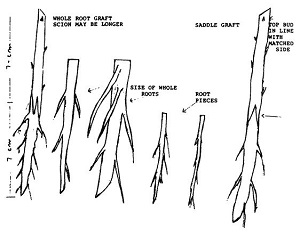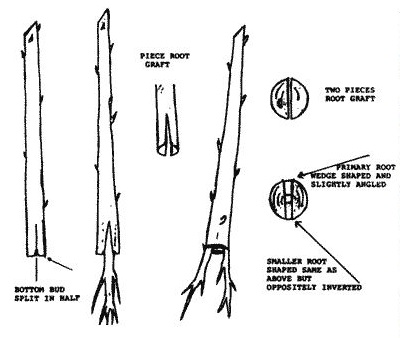From the Archives
of the Rare Fruit Council of Australia, inc.
by Luigi Bazzani, Olea Nursery RMB 44, Manjimup, WA

Root grafting: a neglected technique with potential
[Based on a talk given at a meeting of the International Plant Propagators Society, Perth, 1990].
There
are many different techniques used for grafting and budding, and
descriptions of most of these are readily available. But one method,
root grafting, although a very old method is, I think, from the point
of 'propagation' very much neglected.
It is very simple, works
well with all Apple cultivars, Cherries, Plums, Peaches, Nectarines and
Pears. Many ornamentals may also be propagated by this method -
Rhododendrons, Camellias, Wisterias and some difficult Conifers not
easily produced by cuttings.
This graft can be made using a
whole root or pieces of roots (see figures). For a whole-root graft it
is advantageous that both scion and root be of the same size. Usually a
whip and tongue graft is used, but wedge or saddle grafts can be quite
satisfactory.
The length of the root should be not less than
half the length of the scion. If both are the same length, even better.
This will depend a lot on the internode of each variety or species,
availability of material, and depth at which one intends to plant.
If
scion and root are not of the same size, they will have to be matched
on one side, possibly with the top bud of the scion in line with the
matched side.
Pencil-sized 'root-scions' are ideal for this type
of graft. Roots of larger diameter may lack fibrous roots, depending on
the species, and be more difficult to take.
Due to the scarcity
or poor quality of the big-sized roots, most work is done using smaller
root pieces, from 2-8 mm diameter and 40-80 mm long. I personally have
grafted thousands of Apple trees in the past using root pieces with
excellent results.
The diameter of the scion may also vary, from 3-20 mm, and the length as mentioned for the whole root graft.

The
scion is split at the bottom by starting through the bud (Apple, Cherry
etc.) or node ex-branchlet (Camellia, Conifers). This is very
important. The cutting is then divided into two halves of equal
consistency. If this operation is done properly, very often there is no
need to bind the graft. 

The best of two root pieces is cut wedge-shaped and slightly
angled (8-15 mm long) and inserted into the split cutting on the bud or
node side. 
The
second and smaller root in the opposite side is shaped in a similar
fashion. For a two-piece root graft the cutting needs to be at least 6
mm or above in diameter. For smaller cuttings, one root piece is more
suitable.
Always remember to maintain the polarity of the roots
in all the grafts. The best way to do it is to cut the root pieces
across the bottom on a slant. If this procedure is always adopted no
mistakes will be made.
For securing the graft, I have used with
good results a 15-18 cm long piece of thread obtained from a hessian
sugar bag or burlap. This material will decompose very easily and will
not strangle the graft. I do not recommend budding rubber.
Planting
out for deciduous trees depends a lot on the climatic conditions. For
subtropical Western Australia, grafts may be planted as soon as ready.
For
colder areas, early winter grafts can be stored at 5-8°C and
planted out later, after 4-10 weeks. Store them in a mixture of clean
sand, perlite, peat moss and reasonably moist. Plants susceptible to
crown gall may be dipped in a 'No Gall' solution.
I prefer to
see all these grafts planted deep in a way that only two buds are
exposed. Evergreen stock will have to be provided with a controlled
environment to obtain a good take. With today's facilities - fog, mist,
temperature control - the success of this type of grafted cutting has
improved greatly.
I have noted over the years, that some plants,
however reluctant to provide themselves with their own roots, will do
so if a small root-piece is inserted at the bottom of them. In this
case, wounding and application of rooting hormone will also help.
Others
will produce roots better only on succulent successive young growth.
You plant the graft at soil level and as the young growth starts, cover
it with more soil so that the young roots can develop on the new
growth. In this case the graft becomes a 'nurse graft'. Eventually the
initial root may completely disappear.
When you are sure that
this will occur on a particular plant, then you can use a rubber tie,
this will strangle the initial root and allow the young plant to
develop their own roots.
As you can see this system of grafting may be useful when conventional cuttings are not a proposition.
As
well as its use in the production of commercial plant varieties, the
Bazzani method has great potential in reproducing rare and unusual
plants. If an uncommon plant is bought in from an interstate nursery,
or released from quarantine, there is the opportunity to multiply it
rapidly and get several plants for the cost of one. Take the plant out
from the pot, tease out the roots, and select several end pieces. Cut
these off and combine them with stem pieces from the top of the plant,
using a two-piece root graft. I have done this myself successfully,
with fruit plants which were just passing through my hands, taking a
tiny piece of root and stem before passing them on.
Of
course, with this method it does not matter whether the original plant
is a seedling or is already a graft, perhaps using both a clonal
understock and a selected top variety - you know the roots and the
scion are compatible because the plant is there in front of you. If you
happen to come across a bud sport or mutation, say a prostrate form of
tagasaste, that form or sport can be multiplied up from just the one
plant.
The
method can also be used to propagate from a single unusual seedling, or
a rare isolated plant discovered in the wild. It may be a bit more
laborious to dig down to discover suitable root pieces in these cases,
but the amount of material taken is so small there is no worry about
harming a rare and possibly endangered plant - the technique can
actually be used to increase the number of plants and reduce its
endangered status. ---David Noel, WANATCA Yearbook Editor
Back to
Grafting Techniques Page
|
|


